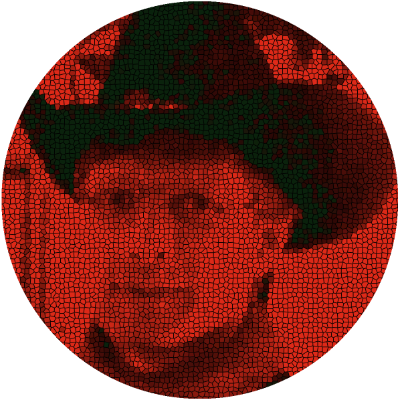













 … but definitely something to blog about.
… but definitely something to blog about.
Documenta 12 primarily seems to be a three artist show of Kerry-James Marshall, Juan Davila and John McCracken with works of some 100 other artists mixed in.
While Marshall’s and Davila’s collage style paintings are very political and present some kind of neo-realisme, MacCrackon is a minimal Artist who works mostly with shiny and colorful gemetrical plastic objects, often attached to walls.
The pieces of these three artists are are distributed over all of the five main locations of Documenta 12. Between them one finds many installations and photo works, surprisingly few videos and hardly any media art other than conventional video (exception: Harun Farocki’s installation analyzing last year’s football world cup final). Many of the works cary political messages or suggest them by featuring regions of which the anti-globalization sympathizer, which we can assume the average Documenta visitor to be, knows, that they are shaken by disastrous political situations. In that Documenta is very affirmative for the kind of concerned people we all are. Yet the perspective seems quite euro-centric, even when choosing artists from those regions like Romuald Hazoumé, whose boat made of oil canisters which are cut up so the walls of the look like they are made of hundreds of faces. People succeeding – or more often not succeeding – in escaping Afrika are obviously of European concern. It still insults my intelligence to be told exactly the same thing I’m being told in the evening news every night using this kind of obvious symbolic arrangement.
Generally there is little revealing, let alone humorous, stuff to be found. Seeing the show, you often find yourself thinking: “got the message, next please”. Not that all art needs to be revealing, but in an exhibition of that size one can expect some works that are. The lack of them seems like a deliberate curatorial choice.
Instead there are works that try hard to come across meaningfully and end up as involuntary caricatures, like James Coleman’s pathetic video featuring Harvey Keitel. I’ve once left from a movie starring Keitel in similar poses (Ulysses’ Gaze). Coleman’s video is worse, since it is in a way an essence of the annoying parts of that movie. A friend of mine liked the video installation. He admitted though that he had not understood a word and had no clue, what it was about. I have a clue and I’m pretty certain that not understanding the words would not have helped much in my case.
The 1001 chinese visitors that Ai Weiwei invited to Kassel can become what Jonathan Borofskys “Man walking to the sky” was for Documenta 9, if they don’t misbehave. It is hard to imagine though, that we will see petitions by Kassel citizens asking the visitors to stay.
There is much to say about the exhibition design. The much criticized Aue-Pavilion is indeed quite ugly and there is a permanent noise from the ventilation system. When it’s raining one also hears the noise of the rain on the roof, which is cozy, but can be annoying. At least during last week’s preview, when it was not as crowded as one can expect it in the coming weeks, the pavilion was more inviting than Fridericianum, which always stresses me out, no matter how much I like the art that it contains. But that is just a personal thing.
Almost bizarre is the labeling at Documenta 12. Generally it only provides minimal information (name of the artist, year, name of the piece), never the artist’s place of birth or other background information. The labels are usually placed, so one sees the art before the label. Wherever possible the labels are even placed, so one doesn’t see them immediately. This is how the organizers try to teach us how to look at art. I’m sorry, but I don’t need Mr. Buergel telling me how I have to view art.
The fight against the terrible monopoly of English as a world language is another mission the Documenta team is on. When there are accompanying texts, they are often available in German and French only. I saw one work in the pavilion with only French text and no German, but there is hope that they changed it before the actual opening. Is this still the spirit of Catherine David, who is famous for her signs at conferences “Catherine David speaks in French”?
Documenta always produces free-riders who place their artistic work (or just about anything for that matter) in it’s periphery. Sometimes they can be quite successful and enrich the Documenta experience. A compensation for the severe lack of humor in the show was an intervention with 12 rally cars, one for each Documenta, covered with mash-ups of brand logos and artist’s names. The cars went on a tour to the big art events this summer (except the venice biennial). In Kassel the artist and all drivers happened to stay at the same camping place as we did. I thought that the intervention was a very smart comment on the mechanics of the hype and brand business “art”. At the same time it also relates to the practice of tuning cars that is usually does not earn much respect from the art world or anybody who chose another life style than beers on weekends and nights in the garage. Yet the dedication of car tuners is probably quite similar as that of many artists and it is safe to say that many artists’ as well as urban designers’ reflection does not go beyond their fascination for sheer form.
The logos on the 12 cars consist of well known logos, like the ones of Shell and Mastercard with artist’s names instead of corporation’s. While the combinations are accidental, mostly chosen for resemblance, it is still a lot of fun to look at how Magritte connects to Shell and Marc Chagall to MasterCard.
